To achieve pro-level portraits with a mobile studio setup, you'll need the right gear and techniques. Start with a high-quality smartphone featuring multiple lenses and strong processing power. Invest in portable LED panels and collapsible reflectors for versatile lighting control. Choose a compact, wrinkle-free backdrop for a professional look. Master manual camera settings using specialized apps that support RAW capture. Practice effective posing techniques and apply key composition principles to create visually striking images. Don't forget post-processing with mobile editing tools to refine your shots. With these essentials, you're well on your way to capturing stunning portraits on the go. Dive deeper to access the full potential of your mobile studio.
Choosing the Right Smartphone

When it comes to choosing the right smartphone for your mobile studio, you'll need to contemplate several key factors.
First, consider the camera quality. Look for a phone with a high-resolution main camera, preferably 12MP or higher, and multiple lenses for versatility. Optical image stabilization is essential for sharp images, especially in low light conditions.
Next, evaluate the phone's processing power. A powerful processor guarantees smooth operation of editing apps and quick image rendering. RAM is also important; aim for at least 6GB to handle resource-intensive tasks.
Storage capacity matters too. Opt for at least 128GB or a phone with expandable storage to accommodate your growing portfolio.
Battery life is another vital aspect. Choose a phone with a large battery capacity to last through long shooting sessions.
Consider the display quality as well. A high-resolution OLED or AMOLED screen will help you accurately assess your images' colors and details.
Essential Lighting Equipment
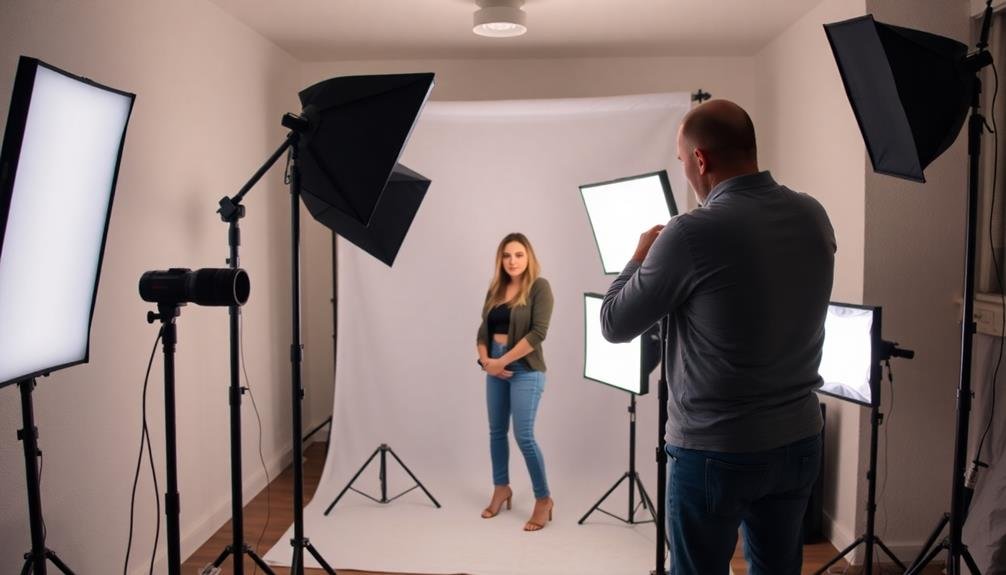
When setting up your mobile studio, lighting is vital for professional-looking results.
You'll want to take into account portable LED panels for their versatility and brightness control, collapsible reflectors to bounce and soften light, and compact softboxes for diffusing harsh illumination.
These essential lighting tools will help you achieve ideal exposure and create the desired mood for your mobile photography or videography projects.
Portable LED Panels
For any mobile studio setup, portable LED panels are indispensable. These lightweight, versatile lighting solutions offer you exceptional control over your portrait lighting. LED panels provide continuous light, allowing you to see exactly how your subject will be illuminated before you take the shot.
When choosing LED panels, look for models with adjustable color temperature and brightness. This flexibility lets you match ambient light conditions or create specific moods. Opt for panels with high CRI (Color Rendering Index) to guarantee accurate color reproduction in your portraits.
Consider investing in a set of at least two LED panels. This setup enables you to create a key light and fill light combination, giving you more control over shadows and highlights. Some panels come with built-in diffusers, but it's wise to have additional modifiers on hand to soften the light when needed.
Battery-powered LED panels are ideal for on-location shoots, freeing you from power outlet constraints. Look for panels with long battery life and the option to use AC power when available.
Collapsible Reflectors
While LED panels offer great control, collapsible reflectors are another key piece of lighting equipment for your mobile studio. These versatile tools bounce existing light onto your subject, softening shadows and adding a natural fill. You'll find them indispensable for outdoor shoots or when working with limited power sources.
Collapsible reflectors come in various sizes and colors, each serving a different purpose. The most common types include:
- Silver: Increases contrast and creates a cooler tone
- Gold: Adds warmth and enhances skin tones
- White: Provides soft, neutral fill light
- Black: Absorbs light to deepen shadows
Choose a 5-in-1 reflector for maximum versatility. It typically includes all the above options plus a translucent diffuser.
When selecting a size, consider portability and the subjects you'll be photographing. A 32-inch reflector is a good all-around choice for portraits.
To use a reflector effectively, position it opposite your main light source. Adjust the angle to direct light where it's needed most.
You can hold it yourself for quick shots, but a reflector holder or stand will free up your hands and allow for more precise adjustments.
With practice, you'll master this essential tool for creating professional-looking portraits in any location.
Softboxes for Diffusion
Light shapers are essential for creating professional-looking portraits, and softboxes are among the most versatile options. These rectangular or octagonal diffusers soften and spread light, creating a flattering effect on your subject's skin and reducing harsh shadows.
When choosing a softbox for your mobile studio, consider portability and ease of setup. Collapsible softboxes are ideal for on-location shoots, as they're lightweight and compact when folded. Look for models with quick-release mechanisms for swift assembly.
Size matters too; a 24×36 inch softbox is versatile for individual portraits, while larger sizes offer broader coverage for group shots. You'll want softboxes that are compatible with your existing light sources, whether they're speedlights or strobes. Some models come with built-in speed rings, while others require separate adapters.
Don't forget about the inner diffusion panel and outer baffle, which work together to create smooth, even light. Experiment with softbox placement to achieve different effects. Position it close to your subject for softer light or farther away for more contrast.
Angling the softbox can create dramatic shadows and highlight facial features. With practice, you'll master this essential tool for stunning, professional portraits.
Backdrop Selection and Setup

Choosing the right backdrop is essential for a polished, professional look in your mobile studio. Consider the subject matter and style of your portraits when selecting a backdrop. Solid colors, especially neutral tones, are versatile and won't distract from your subject. For a more dynamic look, you might opt for textured or patterned backdrops.
When setting up your backdrop, make certain it's wrinkle-free and properly secured. Use a sturdy backdrop stand and clamps to keep it in place. Position your subject at least 3-4 feet away from the backdrop to avoid casting shadows and create depth in your images.
For a mobile studio, collapsible backdrops are invaluable. They're lightweight, easy to transport, and quick to set up. Here are some popular options:
- Muslin backdrops: Affordable and versatile
- Paper rolls: Disposable and great for clean looks
- Vinyl backdrops: Durable and easy to clean
- Pop-up backdrops: Ultra-portable and quick to deploy
Remember to bring gaffer tape for securing edges and smoothing out wrinkles.
With the right backdrop and proper setup, you'll create a professional-looking environment anywhere, elevating the quality of your mobile studio portraits.
Camera Apps for Professional Results

To elevate your mobile photography to professional standards, you'll need to master camera apps that offer manual mode controls.
Look for apps that allow you to adjust settings like ISO, shutter speed, and white balance, giving you full creative control over your shots.
Additionally, guarantee your chosen app supports RAW capture, enabling you to retain maximum image data for post-processing flexibility.
Manual Mode Mastery
Three key elements separate amateur mobile photographers from professionals: control, precision, and consistency. Mastering manual mode on your camera app is essential for achieving these elements. By taking full control of your camera settings, you'll be able to capture pro-level portraits in any lighting situation.
To excel in manual mode, focus on understanding and adjusting these key settings:
- ISO: Controls light sensitivity and grain
- Shutter speed: Affects motion blur and exposure
- Aperture: Determines depth of field (if available on your device)
- White balance: Guarantees accurate color reproduction
Start by practicing in consistent lighting conditions. Experiment with different ISO levels to find the sweet spot between brightness and noise. Adjust shutter speed to freeze motion or create artistic blur. If your device allows aperture control, use it to achieve the desired depth of field for your portraits.
As you become more comfortable with manual settings, you'll notice a significant improvement in your portrait quality. You'll be able to tackle challenging lighting situations, capture the perfect exposure, and maintain a consistent style across your work.
RAW Capture Capabilities
RAW capture is a game-changer for mobile photographers aiming for professional results. It allows you to retain all the image data from your phone's sensor, giving you greater flexibility in post-processing. To harness this power, you'll need a camera app that supports RAW capture.
Here's a comparison of popular RAW-capable camera apps:
| App Name | Price | RAW Format | Key Features |
|---|---|---|---|
| Halide | Paid | DNG | Manual controls, Depth capture |
| ProCam | Paid | DNG | Time-lapse, Slow shutter |
| VSCO | Free/Paid | DNG | Built-in presets, Social sharing |
| Lightroom Mobile | Free/Paid | DNG | Cloud sync, Advanced editing |
| Moment Pro | Paid | DNG | Histogram, Focus peaking |
When shooting RAW, you'll have more control over white balance, exposure, and color grading during editing. However, RAW files are larger and require post-processing to look their best. They're ideal for challenging lighting situations or when you need maximum image quality. Remember to adjust your phone's storage settings to accommodate these larger files, and invest in a reliable backup solution to protect your work.
Posing Techniques for Smartphone Portraits
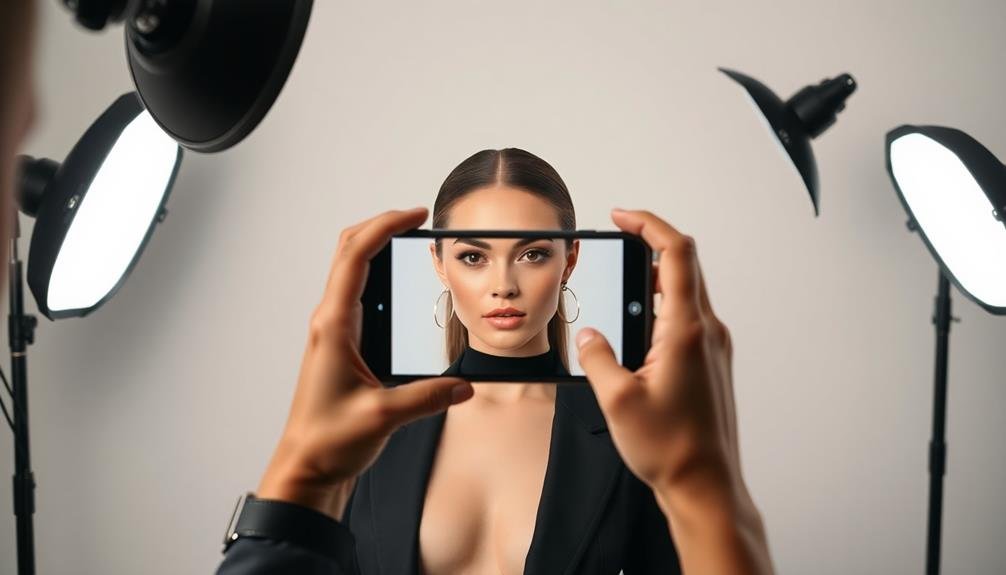
Mastering posing techniques for smartphone portraits can elevate your mobile photography game from amateur to professional. When working with limited space and equipment, it's essential to guide your subjects effectively.
Start by ensuring your model is comfortable and relaxed. Encourage natural poses that highlight their best features and personality.
Consider the rule of thirds when framing your shot. Position your subject slightly off-center for a more visually appealing composition. Pay attention to the background and use it to complement, not distract from, your subject.
Experiment with different angles by moving around your model or asking them to adjust their position slightly.
For flattering smartphone portraits, try these key posing techniques:
- Have the subject lean slightly towards the camera
- Ask them to turn their body at a 45-degree angle
- Encourage gentle movement to capture more dynamic shots
- Guide them to relax their shoulders and jawline
Remember to communicate clearly with your subject throughout the session. Offer positive feedback and demonstrate the poses yourself if needed.
With practice and patience, you'll develop a keen eye for smartphone portrait posing that rivals traditional studio setups.
Composition and Framing Principles
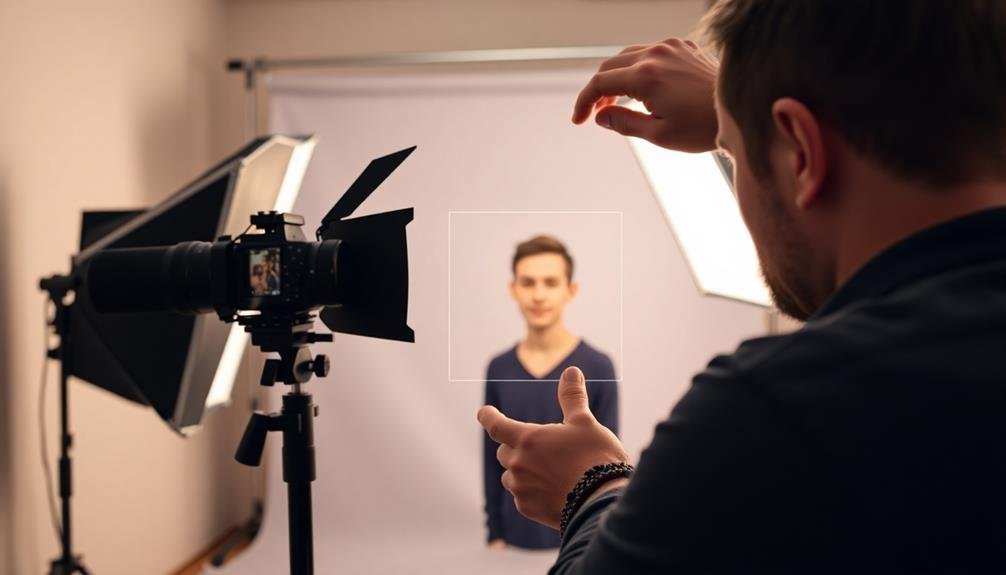
While posing techniques are essential for great portraits, understanding composition and framing principles is equally important for creating stunning mobile photos.
Start by applying the rule of thirds, dividing your frame into a 3×3 grid and placing key elements along these lines or at their intersections. This creates balance and visual interest in your shots.
Pay attention to leading lines, using natural elements or architectural features to guide the viewer's eye towards your subject.
Experiment with symmetry and patterns to add visual appeal, but don't be afraid to break these rules for dramatic effect.
Consider the background carefully, ensuring it complements rather than distracts from your subject.
Use negative space to create a sense of isolation or focus, and play with depth of field by adjusting your smartphone's portrait mode settings.
Frame your subject creatively using natural elements like doorways, windows, or foliage.
Vary your perspective by shooting from high or low angles to add dynamism to your portraits.
Remember to leave enough headroom and avoid cutting off limbs at awkward points.
Post-Processing Tools for Mobile Editing

After capturing your mobile portraits, post-processing tools can take your images to the next level. Many powerful editing apps are available right on your smartphone, allowing you to enhance and refine your portraits without transferring them to a computer.
Start by choosing a versatile editing app like Snapseed, VSCO, or Lightroom Mobile. These apps offer a wide range of adjustments, from basic exposure and color corrections to more advanced tools like selective editing and healing brushes.
When editing your mobile portraits, focus on these key areas:
- Exposure and contrast
- Color balance and saturation
- Skin smoothing and retouching
- Sharpening and noise reduction
Pay attention to the skin tones, ensuring they look natural and not overly processed. Use selective editing tools to brighten eyes, whiten teeth, or enhance specific facial features.
Don't forget to crop and straighten your images if needed. Experiment with different presets or filters, but be careful not to overdo it. Aim for a consistent editing style across your portfolio.
Frequently Asked Questions
How Do I Manage Battery Life During Long Portrait Sessions?
To manage battery life during long portrait sessions, you'll want to bring spare batteries, use power banks, and optimize your camera settings. Turn off unnecessary features, dim your screen, and use airplane mode when possible to conserve power.
What's the Best Way to Clean Smartphone Lenses for Optimal Image Quality?
To clean your smartphone lens, use a microfiber cloth to gently wipe away dust and smudges. For stubborn dirt, lightly dampen the cloth with distilled water. Don't use harsh chemicals or abrasive materials that could damage the lens coating.
How Can I Minimize Camera Shake When Shooting Handheld Portraits?
To minimize camera shake, you'll want to stabilize your hands. Hold your breath, tuck your elbows, use a faster shutter speed, and activate image stabilization. Consider using a tripod or grip for even steadier shots.
Are There Any Accessories to Improve Smartphone Audio for Video Portraits?
You can enhance your smartphone's audio for video portraits with external microphones. Try lavalier mics for clear voice recording, shotgun mics for directional sound, or wireless systems for freedom of movement. Don't forget windscreens for outdoor shoots.
How Do I Protect My Equipment When Shooting Portraits in Challenging Weather Conditions?
You'll want to invest in weatherproof covers for your camera and lenses. Use rain sleeves, sealed cases, and silica gel packets. Don't forget to protect your tripod and lighting equipment. Always have microfiber cloths handy to wipe off moisture.
In Summary
You're now equipped to create stunning pro-level portraits with just your smartphone. Remember, it's not about having the fanciest gear, but how you use what you've got. Experiment with lighting, backdrops, and poses to find your unique style. Don't forget to fine-tune your shots with mobile editing apps. With practice and these mobile studio essentials, you'll be capturing professional-quality portraits in no time. Keep shooting and refining your skills!


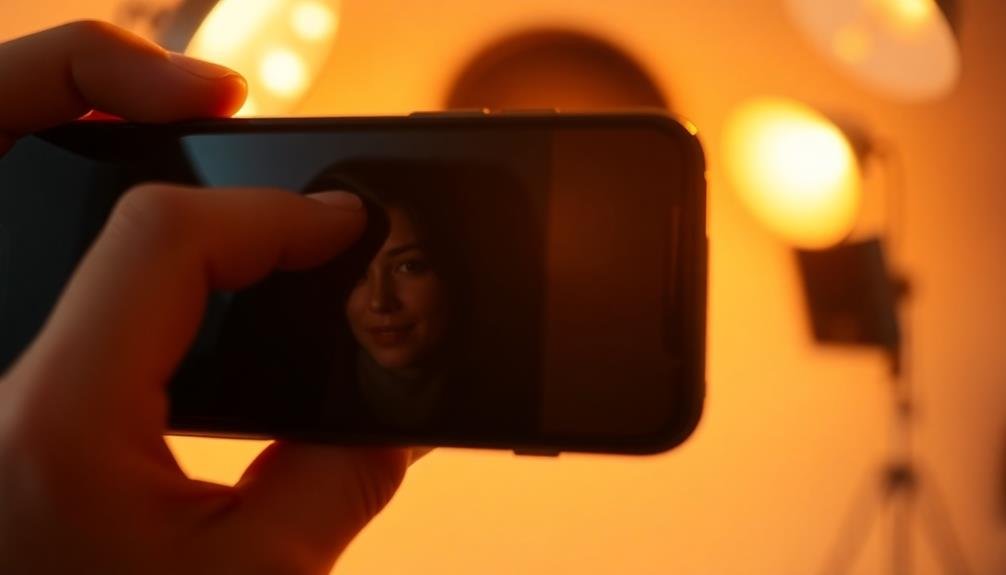
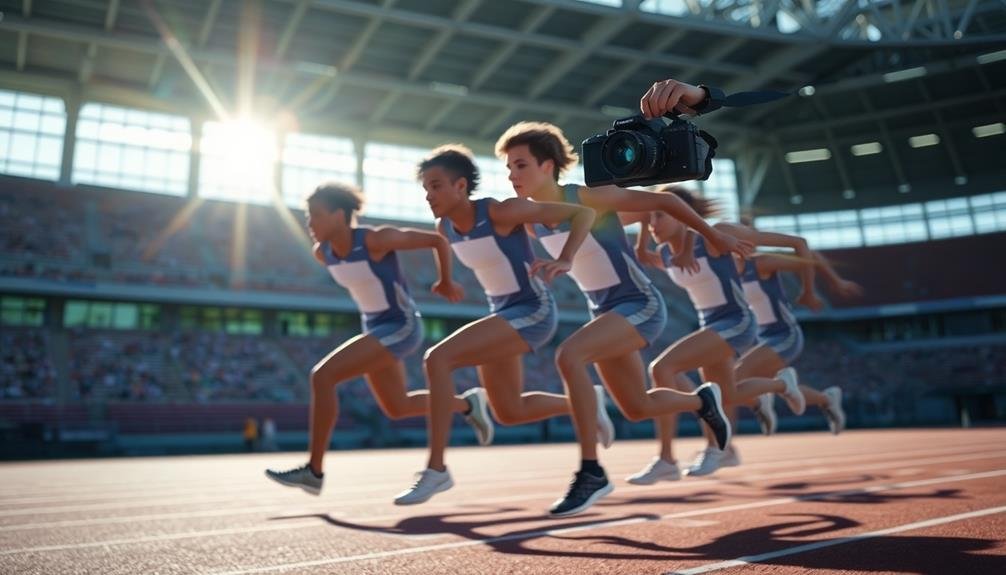
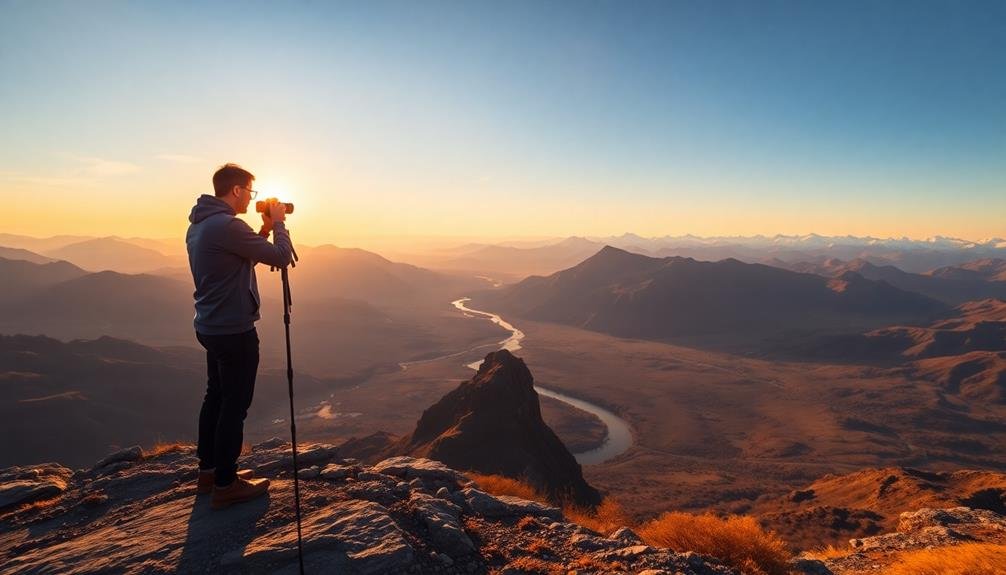
Leave a Reply